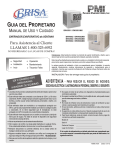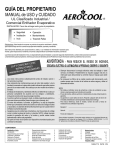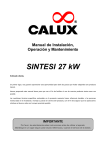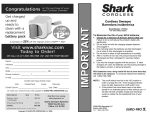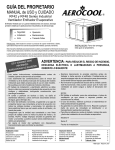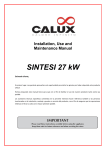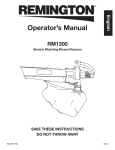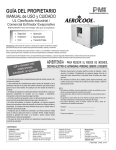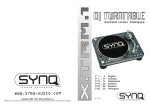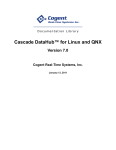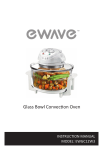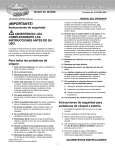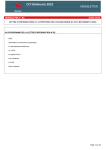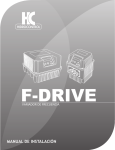Download WH2906-HE2913 rev 10-13.cdr - Phoenix Manufacturing Inc.
Transcript
Read all instructions carefully before installation. This cooler must be connected to 120 Volt AC, 60 Hz (cycle) power only. NOTE: Improper voltage will void the pump and/or motor warranties and may cause serious personal injury or property damage. This cooler must be plugged into a GFCI protected receptacle, which has been properly installed in accordance with all local and national codes. If you are not sure that the receptacle is GFCI protected, consult with a qualified electrician. This cooler is equipped with a power cord having an equipment grounding conductor and grounding plug. Do not attempt to defeat this safety device by removing the grounding pin. Use of an extension cord is not recommended. Do not operate if plug or cord is damaged in any way. If the unit is damaged or malfunctions, do not continue to operate it. Always disconnect electrical power to unit before attempting to work on or service your cooler. Pump water tube has a restricting orifice to assure proper water flow rate to the pad. Do not remove this restrictor! 1-999-2461 Date: 10/13 Place of Purchase: Date of Purchase: Serial # Model # Do not locate unit near exhaust or vent pipes as odors or fumes may be drawn into cooler. Use of anode devices, chemical additives or treatments in this cooler will void the warranty. Your warranty does not cover shipping damage. Report all shipping damage at once to dealer or carrier making the delivery. For future reference, record the model and serial numbers, date and place of purchase of your evaporative cooler here: NOTE: Remove the plug from the electrical receptacle by pulling on the plug and not the cord. Do not operate this blower (fan) motor with any solid-state speed control device. Do not operate this unit with pad frame or air outlet grille removed, this may cause the fan motor to overload and damage the motor. TO REDUCE THE RISK OF FIRE, ELECTRIC SHOCK, OR INJURY TO PERSONS, OBSERVE THE FOLLOWING. WARNING - INSTALLER: Please deliver this guide to owner. Safety Installation Start-up Operation Maintenance Trouble Shooting The first section, Installation and Start-Up, gives details for installation. The second section, Maintenance, contains operational and maintenance instructions, while Troubleshooting includes information on commonly encountered problems. This guide will provide you with information needed to mount, operate, inspect, maintain, and troubleshoot your window evaporative air cooler. Congratulations: You have purchased a product of superior performance and design, which will give the best service when properly installed, operated and maintained. PHOENIX MANUFACTURING, INC. GUÍ A DEL PROPIETARO MANUAL DE USO Y CUIDADO ENFRIADOR EVAPORATIVO de VENTANA: Modelo WH2906 & HE2913 Para Asistencia al Cliente LLAMAR 1-800-325-6952 NO REGRESARLO A LUGAR DE COMPRA! Felicitaciones: Usted acaba de comprar un producto de superior rendimiento y diseño, que la dará el mejor servicio cuando sea propiamente instalado, operado y mantenido. Seguridad Instalación Incio Operación Mantenimiento Trazando Fallas Este manual fue diseñado para proporcionarle a usted y a su instalador la información necesaria para montar, operar inspeccionar, mantener y encontrar cualquier falla en su enfriador. La primera sección de Instalación e Inicio, es especialmente para el instalador. La sección segunda, Mantenimiento, contiene instrucciones de operación y mantenimiento para el propietario, mientras que la sección de Detección de Problemas incluye información sobre los problemas mas comunes. INSTALADOR: Favor de entregar esta guía al propietario. STAS NSERVE E LEA Y CO NTES IMPORTA EGURIDAD S IONES DE INSTRUCC WINDOW COOLER MODEL WH2906 & HE2913 For Customer Assistance CALL 1-800-325-6952 DO NOT RETURN TO PLACE OF PURCHASE! USE AND CARE MANUAL OWNER’S GUIDE PHOENIX MANUFACTURING, INC. ADVERTENCIA - PARA REDUCIR EL RIESGO DE INCENDIO, DESCARGA ELÉCTRICA O LASTIMADURAS A PERSONAS, OBSERVE LO SIGUIENTE: Lea estas instrucciones cuidadosamente antes de instalar, operar o dar servicio a la unidad. Este enfriador debe ser conectado a una fuente de 120V c.a. 60 ciclos solamente. NOTA: voltaje impropio anulará la garantía del motor y/o la bomba y podría causar serias lastimaduras personales o daños a la propiedad. Este enfriador debe ser enchufado a un receptáculo protegido con GFCI, que ha sido propiamente instalado con todos los códigos locales y nacionales. Si no tiene seguridad que el receptáculo no está protegido con GFCI consulté con un electricista competente. Este enfriador viene equipado con un cordón con conductor y clavija de tierra para el equipo. No trate de anular el dispositivo de seguridad removiendo la clavija de tierra. No se recomienda el uso de extensiones eléctricas No lo opere si el cordón o la clavija están dañados en cualquier forma. Si la unidad está dañada o funciona mal, no continue operándola. Siempre desconecte la corriente eléctrica de la unidad antes de trabajar o darle servicio a su enfriador. La manguera de agua tiene un restrictor con orificio que asegura el flujo de agua propio para el filtro. No removerlo! Remueva el cordón del receptáculo eléctrico jalando de la clavija y no el cordón. No opere el motor de la turbina con dispositivos transistorizados para controlar la velocidad. No opere la unidad sin el filtro y/o la rejilla de aire, esto puede causar que se sobrecargue el motor y dañarlo. NOTA: No instale el enfriador cerca de extractores o tubos de ventilación ya que olores o vapores pueden ser inducidos en la unidad. El uso de ánodos, aditivos químicos o tratamientos en esta unidad anulan la garantía. Su garantía no cubre daños de envío. Reporte cualquier daño de envío de inmediato al distribuidor o al transportador realizando la entrega. Para futura referencia, anote el modelo, número de serie, fecha y lugar de compra de su enfriador evaporativo: Modelo #: Serie #: Fecha de Compra: Lugar de Compra: 1-999-2461 Date: 10/13 INTRODUCCIÓN Ester manual es una guía de procedimientos para una instalación propia junto con información de un cuidado razonable y mantenimiento que le asegurará un enfriamiento seguro, económico y sin problemas. El no seguir estas instrucciones puede dañar su enfriador, incapacitar su operación, crear un potencial para una seria lastimadura personal y/o anular la garantía. Lea cuidadosamente Notas para Salidas de Aire / Enfriamiento Máximo Ya que los enfriadores funcionan mejor cuando el escape de aire es en abundancia, usted puede dejar puertas o ventanas abiertas para que su casa pueda respirar. Para obtener la capacidad máxima de su enfriador, y ayudar a mantener insectos, polvo, tierra, etc fuera del espacio enfriador, la casa debe mantenerse ligeramente a una presión positiva (aire entrando la casa sea más que el que sale) Esto se controla con que tanto se abran las ventanas y puertas. ¿Que tanto debe habrir sus ventanas o puertas? Debe habrir sus aberturas hasta que el aire dentro de la casa casi se balance con el aire de afuera. Un metodo usado para determinar si el aire esta razonablemente es el de poner un pedazo de papel en contra del alambre mosquitero de la ventana más lejana al enfriador y ajustar la abertura de las ventanas hasta que el papel se quede lijeramente en el alambre mosquitero de la ventana. Usted puede ajustar diferentes ventanas en la casa para dirigir más flujo de aire a las areas que estén ocupadas durante diferentes tiempos del día o la noche (ejemplo: ventanas de la sala durante el día, de la recámara durante la noche) INSTALACION Montando el enfriador La instalación normalmente envuelve el situar la unidad en una ventana apropiada y usando el juego de cadena incluido o la construcción de una plataforma o tarima para que soporte el peso del enfriador. Ya que cada instalación es diferente, los requerimientos exactos para montar y sellar el enfriador en contra del clima será determinado por el sitio y al momento de la instalación. La mayoría de las instalaciones requieren el cerrar la parte sin uso alrededor del ducto, u otras modificaciones al cuadro de la vantana quizás sean necesarias. Vea ilustración (Fig. 2) para instalación típica. Instalacion de la cadena: Remueva el filtro del enfriador. Situe el enfriador de talmanera que el ducto descanse en el umbral de la ventana y los angulos rejillas cejas esten dentro de la avertura de la ventana. Usando una llave ajustable, ajuste firmemente las piernas en contra de la pared para nivelar y detener el enfraidor en su lugar. Atornille los 2 ganchos roscados en el marco superior afuera de la ventana. Enganche el extremo de cada cadena a cada gancho. Cocoque los 2 ganchos en “S” en los agujeros de la parte superior trasera del giabinete en ambos lados usando el gancho para agujerar las cuiertas de vinilo. Conecte los ganchos en “S” a la cadena de tal manera que el enfriador quede nivelado. Montado en plataforma o tarima: Construya la plataforma o tarima debajo de la ventana, lo suficiente fuerte para soportar el peso del enfriador (aproximadamente 100 libras). Remueva el filtro del enfriador. PRECAUCION: Desconecte toda la corriente eléctrica del enfriador antes de intentar instalar, abrir, o darle servicio a su enfriador. Fabrique la superficie de la plataforma o tarima de tal manera que la altura sea de 11 5/8” debajo de el punto de descanso del ducto en el marco de la ventana. Cuidadosamente lea los contenidos de este manual y revise los planos del enfriador (Fig. 1 y 2) para que usted se familiarize con las varias partes antes de comenzar el proceso de instalación. Sitúe el enfriador de tal manera que el ducto descanse en el marco de la ventana y las cejas de la rejilla estén dentro del armazón de la ventana. Usando una llave ajustable, ajuste las piernas firmemente en contra de la pared para detener el enfriador en su lugar. NO clave clavos o tornillos a través del fondo y la superficie en que se va a montar, esto anula la garantía. Connect the “S” hooks to the chain so the cooler is level. Aún cuando rutinariamente se inspeccione o de servicio al interior, el enfriador puede empezar accidentalmente. Mantenga todo el personal alejado del enfriador y suministro de corriente al trabajar en él. Antes de darle servicio o limpiar la unidad, desenchufe la unidad del receptáculo de la pared y asegurese que el cordón no sea enchufado de nuevo y el enfriador prenda accidentalmente. No enchufe el cordón en el receptáculo hasta que la instalación o trabajo de servicio esté completo. Construct a platform or stand below the window, strong enough to support the weight of the cooler (approximately 100 pounds). Shelf or stand mounting: Insert “S” hooks into holes in the top rear corner of the cabinet, using the hooks to pierce the vinyl hole cover (2 places). Cierre la ventana para que descanse sobre la parte superior del ducto (en ventanas que cuelgan verticalmente) o ventanas que se deslizan al lado del ducto (ventanas que se deslizan hacia los lados). Bloquee la abertura restante de la ventana con un material apropiado para el caso (plexiglás, hoja sólida de plástico, panel sólido de madera, etc.). Será necesario sellar cualquier unión alrededor del ducto para prevenir la entrada de la lluvia, polvo/tierra, insectos, etc. Cualquier sellador de buena calidad o cinta serviría para el propósito. Attach the 2 screw hooks to the top of the outside window frame. Attach one end of each chain onto each hook. Fig. 2 How much should you open your windows or doors? You should adjust your openings until the air pressure inside the house is nearly balanced with the air outside. A good method to determine when the air is reasonably balanced is to place a tissue paper against the screen in the window or door farthest from the cooler and adjust the other openings in the house until the tissue paper stays lightly on the screen. You can adjust different windows in the house to direct the most airflow to the areas that are occupied during different times of the day or night (example: living room windows during the daytime, bedroom windows at night.) Position the cooler so that the duct rests on the window sill and the grille angle flanges are inside the window opening. Using a adjustable wrench, adjust the legs firmly against the wall to level the cooler and to hold it in place. Remove pad frame from cooler. Antes de intentar instalar el enfriador, asegúrese que las siguientes preparaciones se hayan hecho: Fig. 1 Fig. 2 Lower the window to rest on the top of the duct (vertically hung windows) or slide window closed against side of duct (horizontal slider windows). Block any remaining unused portion of the window opening with a suitable blocking material (Plexiglas, solid plastic sheet, solid wood panel, etc.). It will be necessary to seal any joints around the duct to prevent entry of rain, dust/dirt, insects, etc. Any good quality caulking or foam tape will work. Position the cooler so that the duct rests on the window sill and the grille flanges are inside the window frame. Using a adjustable wrench, adjust the legs firmly against the wall to hold cooler in place. DO NOT drive nails or screws through bottom pan into mounting surface, this will void the warranty. Remove pad frame assembly from cooler. Chain mounting: Installation normally involves locating the unit in a suitable window and using the included chain mounting kit or the construction of a platform or stand to support the weight of the cooler. Since every installation is different, the exact requirements to mount and seal a cooler against the weather will be best determined by the location and the time of the installation. Most installations will require blocking of the unused portion of the window around the duct, or other modifications to the window frame may be necessary. See illustration (Fig. 2) for a typical installation. Fig. 1 Mounting the Cooler Este enfriador tiene que ser enchufado a una fuente de 120 voltios con receptáculo protegido con GFCI (Interruptor de Circuito a Falta de Tierra). Si usted no está seguro si el receptáculo tiene protección GFCI, consulte con un electricista competente. Este receptáculo debe estar situado entre una distancia de 5 pies de la abertura de la ventana. (El cordón de suministro es de 6 pies de largo, el uso de una extensión no es recomendable). Asegúrese que la superficie de soporte es lo suficiente fuerte para soportar el peso del enfriador cuando esté en uso; recuerde cuando el depósito está lleno de agua, el enfriador pesará mucho más que vacío. Instale enfriadores en un ventana donde solamente aire fresco de afuera entre de enfriamiento. Evite el instalar las unidades en áreas que restringen el movimiento libre del aire alrededor y la entrada del enfriador, o cerca de tubos de venteo, extractores de cocina, etc.; ya que repugnantes olores o vapores pueden ser inducidos por la unidad. Asegúrese que la superficie de soporte es lo suficiente fuerte para soportar el peso del enfriador cuando esté en uso. Esta unidad pesará aproximadamente 100 libras cuando opere en plena capacidad. Verifique que la superficie de soporte esté nivelada en todas direcciones. 2 Evaporative Window Cooler - Use and Care Manual Fig. 3 Verify that the supporting surface is level in all directions. Verify that the supporting surface is strong enough to bear the weight of the cooler when in use. This unit will weigh approximately 100 pounds when operating at full capacity. Fig. 3 2 Enfriador Evaporativo de Ventana - Maunal de Uso y Cuidado Install cooler in a window where only fresh outside air can enter. Avoid installing the cooler in an area where the free air movement around and into the cooler is restricted or locations where obnoxious odors or fumes may be drawn into cooler from vent pipes, kitchen exhausts, etc. This cooler must be plugged into a 120 Volt GFCI (Ground Fault Circuit Interrupter) protected receptacle. If you are not sure that the receptacle is GFCI protected, consult with a qualified electrician. This receptacle should be located within 5 feet of the window opening (cooler power cord is 6 feet long, use of extension cords is not recommended). Before attempting to install the cooler, confirm that the following preparations have been made: Even while routinely inspecting or servicing the inside, the cooler can be accidentally started. Keep people and pets away from the cooler and electrical supply when you are working on it. Before opening, servicing or cleaning the unit, unplug the unit from the wall receptacle and take steps to ensure that the cord cannot be plugged back in and the cooler turned on accidentally. Do not plug power cord into the wall receptacle until installation or service work is complete. before attempting to install, open, or service your cooler. CAUTION: Disconnect all electrical power to the cooler Carefully read the contents of this manual and review the drawings of the cooler (Fig. 1 & 2) to familiarize yourself with the various parts before beginning the installation process. INSTALLATION Make the platform or stand mounting surface so that the height is 11 5/8” below the resting point of the cooler duct on the window sill. Since coolers function best when there are plenty of openings for the air to exhaust, you can leave doors or windows open so your house can breathe. To get the maximum capacity of your cooler, and to help keep insects, dust, dirt, etc out of the cooled space, the house should be maintained at a slightly positive air pressure (there should be slightly more air going into the house than is leaving). This is controlled by how much the windows or doors are opened. A Note About Air Exhausting / Maximum Cooling This manual is your guide to proper installation procedures along with information about reasonable care and maintenance that will ensure safe, economical and trouble free cooling. Failure to follow these instructions may damage your cooler, impair its operation, create the potential for serious personal injury and/or void the warranty. Read it carefully. INTRODUCTION Evaporative Window Cooler - Use and Care Manual 3 Operación de Enfriador Conecte el Suministro de Agua Fig 4 P P P P P P Leaks from water lines, pad frame, cabinet, etc. Cooler pad: even wetting, no dry streaks. Confirm water level depth setting is correct. Verify full, even flow in water distribution system. Blower wheel rotates freely, no unusual noises. Check motor mounting, cabinet hardware, setscrews on blower wheel are tight. After initial start-up and for a few weeks afterwards, check for and/or observe the following: Refer to the Troubleshooting Chart on page 6 if necessary. Cabinet Inspection Checklist In case of trouble on any of these steps, refer to the Troubleshooting Chart on page 6. Connect a suitable drain line (garden hose, etc) to the drain bushing. Never drain water onto a sidewalk or other hard surfaced area; mineral build-up or a slipping hazard may occur. Push drain bushing through hole in side of cooler (opposite of float valve), rotate hose until anti-siphon fitting tube is pointing toward bottom of cooler, then assemble and tighten lock nut. Locate drain hose assembly in bottom of cooler and remove lock nut from drain bushing (leave rubber washer in place). Check that the opposite end of the hose is still connected to the drain pump. To minimize mineral scale “build-up”, these window cooler models include an automatically timed drain pump for removing mineral laden water from the cooler pan. It is factory set to operate every 8 hours of unit operation in the “COOL” mode and will run for 5 minutes. Install the drain bushing for the auto-dump drain pump discharge hose in the side of the cooler as follows: (See figure 4) Install fitting for drain pump (HE2913) NOTE: Drain water in accordance with local plumbing codes. To minimize mineral scale “build-up”, use the included bleed-off assembly. Remove the cap from the bleed-off tee; insert the 1/4” diameter black tubing and route the tubing through the 7/16” hole in the side of the cooler opposite of the float valve. Run bleed-off tubing to a proper drain. To prevent siphoning of the water, make sure that the bleed-off tee is above the water level. Install Bleed-off (Model WH2906) P P P P P Open building exhaust / relief vents (windows, doors, etc.) Plug supply cord into receptacle. Switch “COOL” to “ON”. Verify that the pump starts and pad evenly wets. Switch “FAN” to “HIGH”, observe that motor starts and runs. Switch to “LOW”, observe that motor changes to low speed. To verify and check out the cooler installation on initial or annual startup, the following procedure should be followed. CAUTION: Never operate cooler with pad frame(s) or air outlet grille removed. This will result in an overloaded condition and may damage the blower motor. Start-up Check List Cooler mounting is level; window duct is sealed. Power supply cord is correctly routed, safe and secure. Bleed-off / drain pump is correctly installed and fully functional. Water line securely connected, turned on, no leaks noted. Float valve is correctly installed, adjusted for proper water level and fully operational. P Pump impeller turns free and smooth. If in doubt, remove impeller cover (see “Cleaning Pump”). P Blower wheel turns freely. P P P P P Before start-up of the cooler for the first time, or at the beginning of each cooling season, make sure that all required connections, adjustments, etc. have been made. Verify that: before attempting to install, open, or service your cooler. Initial Start-up or Annual Inspection CAUTION: Disconnect all electrical power to the cooler GENERAL INSPECTION Turn on water supply and check for leaks. Adjust float to maintain the water level at 2” to 2 ½”. Connect tubing from water supply to float valve. Place compression nut and ferrule over end of tubing, insert tube into float valve then tighten compression nut to secure. PRECAUCION: Todas las instalaciones de plomería tienen que cumplir con los códigos de edificar y reglas de seguridad, y llevadas a cabo por personal competente solamente. NOTA: Los enfriadores no se deben conectar a sistemas de agua “blanda”. Agua blanda acelera la corrosión y reduce la vida efectiva de los filtros y gabinete. Conecte el suministro de agua como sigue: Controles: Los interruptores se utilizan para seleccionar el modo de operación del enfriador de ventana. Estos interruptores controlan la velocidad de la turbina (ALTA / APAGADO / BAJA) y la operación de enfriamiento (ENCENDIDO / APAGADO). Parrillas giratorias: Gire cada parrilla hasta alcanzar la dirección de aire deseada. La válvula de suministro de agua podría instalarse en un sitio conveniente, para permitir abrir y cerrar para dar servicio o apagado de invierno. Un tubo con un mínimo de 1/4” se debe usar para el suministro de agua hacia el enfriador, Un tubo más grande se debe usar si la distancia es mayor de 100 pies y reducida a 1/4” en la entrada de la unidad. Instale la válvula del flotador en el gabinete como se indica (fig. 3) Conecte un tubo del suministro de agua al flotador. Ponga la tuerca de compresión y la férula sobre el extremo del tubo, inserte el tubo en la válvula y apriételo la tuerca de compresión bien. Abra el suministro de agua y revise si hay fugas. Ajuste el flotador para mantener un nivel de 2” a 2 ½.. Instale el sangrado (Model WH2906) Para minimizar la “acumulación de sarro’, use la sangría incluida. Remueva el tapón del adaptador “T” e inserte tubo negro y guíelo a través del agujero de 7/16’ en el costado opuesto a la válvula del flotador. Recorra el tubo de sangrado hacia un grenaje apropiado. Para prevenir sifónaje del agua, asegure que la “T” del sangrado esté arriba del nivel del agua. NOTA: Drene el agua de acuerdo con los códigos locales de plomería. Instale el aditamento para la bomba de drenaje (HE2913) Para minimizar la "acumulación de sarro", en el modelo HE2912 enfriador de ventana se incluye una bomba con temporizador para remover el agua cargada de minerales del depósito. Ajustado en la fábrica para operar cada 3 horas por 6 minutos en la operación de "COOL". Instale el buje de drenaje para la manguera del sistema automático de drenaje en el costado del enfriador como sigue: (ver figura 4) Coloque el ensamble de la manguera removiendo la tuerca del buje (dejando la arandela de hule en su lugar). Revise si el lado opuesto de la manguera aún esté conectada a la bomba de drenaje. Inserte el buje de drenaje através del agujero en el costado del enfriador (lado opuesto a la vávula), girar la manguera hasta que el aditamento anti-sifón apunte hacia el fondo del enfriador, atornille la tuerca. Conecte una linea adecuada de drenaje (manguera de jardín, etc) al buje de drenaje. Nunca drene el agua en la banqueta u otra area con superficie dura: ya que con la acumulación de sarro se puede poner resbalosa. Install float valve in the cabinet as shown in Figure 3. A water supply valve should be installed at a convenient location, to allow the water supply to be turned on and off for servicing or winterizing. Minimum 1/4“ diameter tubing should be used to provide water to the cooler, larger tubing is recommended if the distance from the valve to the cooler is greater than 100 feet, then reduced to 1/4” at the unit. Fig 4 INSPECCIÓN GENERAL Lista de inspección de pre-comienzo o anual PRECAUCION: Desconecte toda la corriente eléctrica del enfriador antes de intentar instalar, abrir, o darle servicio a su enfriador. Antes de prender el enfriador por primera vez, o en el comienzo de cada temporada de enfriamiento, asegúrese de haber hecho todas las conexiones y ajustes. Verifique que: P Montura del enfriador a nivel; ductos de ventana sellados. P El cordón clavija este correctamente guiado, seguros y fuera de peligro. P Sangrado o bomba de purga están correctamente instaladas y funcionales. P Línea de agua seguramente conectada, abierta, sin fugas notables. P Válvula del flotador están correctamente instaladas y funcionales, ajustado al propio nivel. P Impelente de la bomba gira libre y suave. Si hay duda remueva la cubierta del impelente (véase “limpieza de la bomba”) y revise la rotación. P Turbina gira libremente. Chequeo de empiezo PRECAUCION: Nunca opere la unidad sin el filtro o rejilla del aire. Esto resultaría en condición de sobrecarga y podría dañar el motor de la turbina. Para verificar y chequeo de la instalación del enfriador en el comienzo inicial o anual, siga el siguiente procedimiento. P Habrá las salidas / ventilaciones (ventanas, puertas, etc.) P Enchufe el cordón clavija en el receptáculo de pared. P Verifique si la bomba empezó y los filtros se mojan parejos. P Observe comienza y funciona. En caso de problemas en alguno de estos pasos, refiérase a la lista de trazando fallas en página 6. Lista de inspección del gabinete Después del comienzo inicial y durante inspecciones periódicas, revise u observe lo siguiente: Refiérase a la lista trazando fallas en la página 6 si es que es necesario. P Fugas de las líneas de agua, filtro, gabinete, etc. P Filtro de enfriador: se mojen parejos, no áreas secas. P El ajuste del nivel del agua sea correcto. P Verifique el flujo de agua completo y parejo en el sistema de distribución. P Turbina / motor giran libremente, no ruidos extraños. P Revise la montadura del motor, tornillos del gabinete, tornillos opresores de la turbina apretados. NOTE: Coolers should not be connected to “soft” water systems. Soft water will accelerate corrosion and decrease the effective life of the pad and the cooler cabinet. Connect water line as follows: Rotate each louver ring until desired air flow direction is reached. Grille airflow control: The rocker control switches are used to select the operating mode of the window cooler. These switches control fan speed (HI / OFF / LOW) and the cooling operation (ON / OFF). Connect Water Supply Cooler Operation CAUTION: All plumbing installations must comply with local building and safety codes, and must be performed by qualified personnel only. Controls: Enfriador Evaporativo de Ventana - Maunal de Uso y Cuidado 3 LISTA DE MANTENIMIENTO Mantenimiento regular e inspecciones periódicas son la clave de un bueno y prolongado servicio de su enfriador. El enfriador debe recibir servicio completo a menos una vez por año y más seguido si las condiciones lo requieren (ambiente polvo, uso constante, calidad del agua, etc.) Para máxima eficiencia de enfriamiento, larga vida y apariencia, cada dos meses durante su operación, el enfriador debe ser inspeccionado y limpiado. NOTA: No ponerle brea al depósito de agua. El depósito de su enfriador tiene un acabado con nuestro Peblar XT acabado tipo artefacto. Es tan duro que la brea no se pegará al fondo. La capa se despegará y se soltará, tapando la bomba y el distribuidor de agua. NOTA: No use limpiadores para enfriadores, ánodos, tratamientos u otro aditivo químico en este enfriador. El uso de aditivos o tratamientos para el agua u otro que no sea sangrado anulará la garantía y perjudicará la vida del enfriador. Antes de comenzar la operación de mantenimiento, lea detalladamente todas las instrucciones de mantenimiento y operación y observe todas las precauciones y advertencias. Limpieza PRECAUCION: Nunca lave su enfriador con manguera de jardín; El agua puede dañar el motor y la bomba o infiltrada la casa a través al ducto de ventana. Motores dañados por el agua NO los cubre la garantía. Materiales extraños, sarro, depósitos de sal, minerales etc. Deben de removerse de las rejillas del filtro, fondo, y otros componentes. El acabado duradero de su enfriador se puede poner como en condición de nuevo usando agua tibia y un trapo suave. NOTA: Evite estropajos, estropajos o brochas de alambre, estos dañarán él acabado estimulando la corrosión. Mantenimiento e Inspección IMPORTANTE: Antes de operar el enfriador al comienzo de cada temporada de enfriamiento, gire la turbina y el eje de la bomba con la mano para asegurarse que giren libremente. El no hacerlo podría resultar en un motor quemado. Inspección periódica de su enfriador puede realzar la vida libre de problemas de este. Para máxima eficiencia, cada dos meses durante su operación, o en cualquier ocasión que habrá el enfriador, lo debe inspeccionar. Algunas sugerencias: P ¿Revise por goteras del filtro, gabinete, etc. P ¿Encuentra puntos secos en la paja cuando en operación? P ¿Sonidos extraños en las chumaceras o motores? P ¿La turbina gira libremente? P ¿Flotador al correcto nivel? Limpieza de la bomba y manguera PRECAUCION: No permita que la bomba se caiga y se sumerja; el agua daña el motor. PRECAUCION: Desconecte toda la corriente eléctrica del enfriador antes de intentar instalar, abrir, o darle servicio a su enfriador. Limpie la bomba, la manguera y la ensamble de distribuidor como sigue: Desenchufe el cordón de enfriador, remueva el tornillo de la abrazadera de la bomba y con cuidado remueva la bomba del enfriador. Sacúdala ligeramente para removerla del agua. Para prevenir que se quiebre, con cuidado remueva la placa de la base del impelente y remueva la placa de la base de la bomba. Usando una solución de detergente ligera, limpie los depósitos del cedazo de la bomba, alrededor del impelente y la tapadera de la base. Gire el impelente para destapar material ajeno. Remueva cualquier material (ajeno en el adaptador y la manguera), o entre la manguera y el distribuidor de agua. Enjuague y reinstale la cubierta del impelente. Reinstale la bomba y enchufe el cordón de enfriador. Retocar La dureza, adhesión y suavidad del acabado interno y externo en su enfriador hace que sea extremadamente improbable que la pintura se raspe o se pele. En un evento que esto ocurra, se debe reparar siguiendo los siguientes procedimientos: 1. 2. Lije el área alrededor de las partes de metal descubiertas. Use pintura de fondo y pintura de buena calidad. No use compuestos de asfalto en el depósito de agua ya que se separará, tapando la bomba y el distribuidor de agua. Winter Shut Down LUBRICACION Chumaceras del motor de la turbina y la bomba Las chumaceras están permanentemente lubricadas. Cubierta de Parrilla Modelo HE2913 están proveído con una cubierta de rejilla. La cubierta se usa durante períodos de no uso o apagado de invierno. Lengüetas flexibles en ambos lados aseguran la cubierta a la parilla. Jale las lengüetas hacia fuera y adelante para instalar o remover la parilla. Apagado de Invierno: - Siempre vacie toda el agua del enfriador y de la tubería cuando no esté en uso por periodos prolongados, y particularmente en el término de la temporada. Mantenga la tuberia del agua desconectada en ambos lados para que no se reviente en bajas temperaturas. Cuando ordene partes de reemplazo, siempre refiérase al modelo y número de serie de su enfriador. Use él número de parte en la acompañante lista de partes, como esta ilustrado en los diagramas de su modelo. Reemplazo De Partes Your cooler's water reservoir is finished with our Peblar XT® appliance-type finish. It is so hard that asphalt-type cooler water pan under-coatings will not stick to it. Undercoating will break free, clogging the pump and water distribution system. Drenando When ordering replacement parts, always refer to the serial and model number of your cooler. Use the part numbers listed in the accompanying parts list, as illustrated in the diagram for your model. Push “COOL” and “FAN” switches to the “OFF” position. Turn off water supply to cooler. Model HE2913 is supplied with a grille cover. This cover is used during periods of non-use or for winterizing your cooler. Grille Cover The blower and pump motor bearings do not require lubrication. Blower Motor and Pump Motor Bearings Sand the area around bare metal spots. Prime and paint with a quality paint. Clean water pump and hose assembly as follows: Unplug power supply cord from wall receptacle, remove pump mounting bracket screw and gently lift pump from cooler. Shake gently to remove water. Vacié el depósito para limpieza o al final de cada temporada como sigue: REPLACEMENT PARTS - Always drain all of the water out of the cooler and water supply line when not in use for prolonged periods, and particularly at the end of the season. Keep the water line disconnected from both the cooler and the water supply so it does not freeze. - Disconnect power from cooler during extended periods of non-use. Flexible tabs on each side hold the cover in place over grille. Pull side tabs out and forward to install or to remove cover from grille. Check for leaks from pad frames, cabinet, etc. Any dry spots or streaks on pads when pump is operating? Are the bearings, etc., making any unusual noises? Does the blower wheel turn freely? Is float level set correctly? Lubrication Do not use asphalt type cooler undercoat material in water reservoir. Undercoat will break free, clogging the pump and water distributor. 1. 2. The hardness, adhesion and smoothness of the internal and external finish on your cooler makes it extremely unlikely that scratches or chipping will occur. In the event that finish damage does occur, it should be promptly repaired by the following procedures: Touch-Up Reinstall pump and reconnect power cord. Rinse and reinstall impeller cover plate. Remove any foreign material in the hose adapter (between the pump and hose), or between the hose and the water distributor assembly. Using a mild detergent solution and a soft cloth, clean deposits from screen, around impeller and cover plate. Spin impeller to dislodge any remaining foreign material. To prevent breakage, carefully release the snap-out impeller cover plate and remove cover plate from the pump body. NOTE: Do Not Undercoat the Water Reservoir - Disconecte el enfriador de la fuente durante largos periodos de no uso. CAUTION: Do not allow pump to fall over and become before attempting to install, open, or service your cooler. CAUTION: Disconnect all electrical power to the cooler Ponga el interruptor “COOL” y “FAN” en “OFF”. Cierre el suministro de agua al enfriador. Remueva el filtro y desconecte la manguera en el lado del distribuidor de agua localizado en la parte de arriba del enfriador. Use este lado de la manguera para vaciar el enfriador, fijándose en la cantidad de agua que se va a vaciar. Ponga el interruptor “COOL” en “ON” para bombear el agua fuera del depósito, en “OFF” cuando el depósito esté vacio. Desenchufe el cordón de suministro del receptáculo de la pared. Remueva cualquier sobrante de agua con una esponja o trapo. Regrese la manguera de nuevo al distribuidor, reinstale el filtro en el enfriador. 4 Evaporative Window Cooler - Use and Care Manual Replace pump hose on water distributor, reinstall pad frame assembly into cooler. Remove any remaining water with a sponge or rag. Turn cooler pump on by pushing “COOL” switch to the “ON” position, pumping water out of cooler pan. Switch pump “OFF” when no more water can be pumped out. Unplug cooler power supply cord from wall receptacle. Remove the pad frame assembly and disconnect the pump hose from the water distributor (located at the inside top of the cooler. Place end of hose outside of unit for draining, keeping in mind the amount of water to be discharged. Drain the cooler for cleaning or at the end of the season as follows: Draining P P P P P For maximum efficiency, every two months during operation, or any time the cooler is opened, the cooler should be inspected. Some suggested items to look for: of each cooling season, turn blower wheel and pump motor shaft by hand to make sure they turn freely. Failure to do so may result in burning out motor. IMPORTANT: Before operating cooler at the beginning Maintenance & Inspection NOTE: Avoid using scouring pads, steel wool or wire brushes, as these will damage the finish and encourage corrosion. All foreign materials, mineral scale, hard water deposits, dirt, etc. should be removed from pad frame, water pan and other components. Your cooler's long lasting finish can be brought to like-new condition by using warm water and a soft cloth. garden hose; water may harm motor and pump or seep inside the house through the window duct. Motors damaged by water are NOT covered under warranty. CAUTION: Never wash your cooler cabinet with a Cleaning Before starting any maintenance operation, thoroughly read all operating and maintenance instructions and observe all cautions and warnings. NOTE: Do not use cooler cleaners, cooler treatments, anodes or other chemical additives in this evaporative cooler. Use of any additives or water treatment other than the furnished bleed-off will void your warranty and may impair the life of the cooler. submerged; water will damage pump motor. Cleaning Water Pump & Hose 4 Enfriador Evaporativo de Ventana - Maunal de Uso y Cuidado Regular maintenance and periodic inspection is the key to long and successful service from your cooler. The cooler should receive major servicing at least once a year, more often if conditions require (dusty environment, constant use, poor water quality, etc.) For maximum cooling efficiency, long life and appearance, every two months during operation, the cooler should be inspected and cleaned. MAINTENANCE SCHEDULE Evaporative Window Cooler - Use and Care Manual 5 Los filtros de su enfriador se deben revisar una vez por año.....de preferencia al principio de la temporada. O cuando los filtros requieran revisarse más frecuentemente, de acuerdo con el aire y las condiciones del agua local. Por ejemplo, en áreas donde el contenido de minerales del agua es alto o el aire es sucio, depósitos se acumulan en los filtros, restringiendo el flujo del aire. Reemplace los filtros como sigue: El filtro de su enfriador se deben cambiar dos veces por año.....al principio y a la mitad de la temporada. O cuando el filtro requieran cambiarse más frecuentemente, de acuerdo con el aire y las condiciones del agua local. Por ejemplo, en áreas donde el contenido de minerales del agua es alto, depósitos se acumulan en el filtro, restringiendo el flujo del aire. PRECAUCION: Desconecte toda la corriente eléctrica del enfriador antes de intentar instalar, abrir, o darle servicio a su enfriador. PRECAUCION: Desconecte toda la corriente eléctrica del enfriador antes de intentar instalar, abrir, o darle servicio a su enfriador. Cambiando el filtro (Modelo HE2913) Cambiando el filtro (Modelo WH2906) Reemplace el filtro como sigue: Remueva el retenedor de alambre, usando precaución ya que pueden resortear. Cuidadosamente remueva la paja de el retenedor. Remueva y deseche el filtro viejo. Remueva el armazón del gabinete. Remueva el armazón del gabinete. Coloque el armazón del filtro en una superficie lisa con los retenedores hacia arriba. Observe como los removió / para instalarlos de nuevo. Remueva el retenedor deslizándolo bajo la ceja del armazón. Cuidadosamente remueva y deseche el filtro usado. MODEL WH2906 MODEL HE2913 WIRING DIAGRAM Pre-soak pad and check for air gaps along edges, reinstall pad frame assembly into unit. Replace pad retainer and lock under edge of frame. Sharp points must be buried into pad (they hold pad in place and prevent sagging). Pad thickness should be uniform across the frame. Lay new pad in frame, starting at trough end, making sure pad is snug against trough and outer edges with no air spaces. Pad must completely fill frame (no gaps) or hot air may enter building. Using a mild detergent, wash dirt and scale from pad frame and rinse with fresh water. Wire brushing is not recommended. If finish is damaged or rusting is noted, repair area as noted in the “TouchUp” section. Pre-soak pad (this will help with the wetting of the pad on start-up) . Reinstall pad frame assembly into unit. Place the slot in the end of the new pad over the bottom flange of the pad frame and push the pad down against the flange until it stops. Gently push the top of the pad into the pad frame. Slide the 1” thick pad on top of the large pad already in place. Replace the pad retainer by sliding the retainer under the pad frame flanges . Using a mild detergent, wash dirt and scale from pad frame and rinse with fresh water. Check slots at top of pad frame to be sure they are open and clear. Wire brushing is not recommended. If finish is damaged or rusting is noted, repair area as noted in the “Touch-Up” section. Usando detergente ligero, lave la tierra y sarro del armazón, enjuague con agua fresca. No se recomienda el uso de brochas de alambre. Si se daña el acabado o nota corrosión, repare el área como lo indica la sección de retocar. Ponga el filtro nuevo en el armazón, empezando por el lado de la canaleta, que ajuste con la canaleta y las orillas de los lados sin espacios de aire, el filtro debe llenar el armazón o aire caliente entrará al edificio. El grosor del filtro debe estar uniforme a través del armazón. Reinstale el retenedor de alambre y asegúrelos alrededor del armazón. Puntos filosos metidos en el armazón (detiene el filtro en su lugar y previene que se afloje) Usando detergente ligero, lave la tierra y sarro del armazón, enjuague con agua fresca. No se recomienda el uso de brochas de alambre. Si se daña el acabado o nota corrosión, repare el área como lo indica la sección de retocar. Inserte la ranura del filtro nuevo en la parte de abajo del armazón empujuelo hasta que se detenga. Con cuiado empuje la parte superior del filtro hacia adentro del armazón. Inserte el pedazo de filtro de 1” entre la canaleta y el filtro largo. Ahora inserte el retenedor del filtro en las cejas del aramzón. Pre-remoje el filtro (esto ayudará el que el filtro se humedezca al comenzar) instale el filtro en la unidad. Pre-remoje el filtro y revise si quedaron aberturas a lo largo de las orillas, reinstale el filtro en la unidad. DIAGRAMA de ALAMBRADO MODELO WH2906 MODELO HE2913 Remove pad retainer from frame, using caution as retainer can spring back. Carefully remove all aspen from pad frame. Remove and discard old pad. before attempting to install, open, or service your cooler. before attempting to install, open, or service your cooler. Your cooler pad should be changed at least twice a year… at the beginning of and midway through a season . However, your pad may need to be changed more frequently, depending on local air and water conditions. For instance, in areas where mineral content of the water is high, deposits may build up in the cooler pad, restricting airflow. The condition of your cooler pad should be checked at least once a year; at the beginning of the season is best. However, your pad may need to be checked more frequently, depending on local air and water conditions. For instance, in areas where mineral content of the water is high or the air is dusty, deposits may build up in the cooler pad, restricting airflow. Clean or replace pad as follows: Replace pad as follows: Remove pad frame assembly from cabinet. Remove pad frame assembly from cabinet. Lay pad frame on smooth, flat surface with pad retainer up. Observe the location / placement of the pad retainer. Remove retainer by sliding it out from under the pad frame flange. Carefully remove and discard old pad. Changing Cooler Pad (Model WH2906) Changing Cooler Pad (Model HE2913) CAUTION: Disconnect all electrical power to the cooler CAUTION: Disconnect all electrical power to the cooler Enfriador Evaporativo de Ventana - Maunal de Uso y Cuidado 5 Evaporative Window Cooler - Use and Care Manual TRAZANDO FALLAS : Si un problema obvio ocurre en su enfriador, consulte la siguiente tabla. Si no 6 puede corregir el problema, contacte a un representante competente de servicio. Ajuste el flotador 2 1/2“ de profundidad de agua Válvula de flotador fuera de ajuste Derrame de agua en la unidad ACCIÓN CORRECTIVA: CAUSA PROBABLE: PROBLEMA / SÍNTOMA: Filtros Secos No comienza o no hay entrega de aire Entrega de aire inadecuado Remueva la obstrucción Entrada de agua de la bomba tapada Remplace el ensamble de flotador Válvula no funciona Libere el flotador de la obstrucción Movimiento del flotador obstruido Revisar el receptáculo de corriente y el cordón Corriente eléctrica desconectada Abrir el suministro de agua Agua hacia el enfriador cerrada Repare o remplace alambres Alambrado no funciona Remplace el interruptor Interruptor no funciona Limpie la basura de las canaletas Canaleta de filtro tapada Localice y remueva la obstrucción Linea de agua tapada Remplace la bomba Bomba no funciona Abra ventanas para aumentar el flujo Insuficiente escape de aire Remplace el interruptor Interruptor no funciona Remplace el motor Motor no funciona Diagnosticar la causa y corregir el probelma Fusible quemado o disyuntor se apaga Remplace filtros Apriete tornillos de turbina Check power receptacle and cord Turbina floja con eje Turn on water supply Electrical power disconnected Motor does not start or no air delivery Filtros tapados Repair or replace non-functional wiring Water turned off to cooler Remplace el motor Non-functional wiring Revise el voltaje Replace switch Bajo voltaje Clear debris from trough Non-functional switch El motor se prende y se apaga Locate and free obstruction Pad trough clogged Reinstale el filtro o rejilla Clogged water line Eje de motor congelado Replace water pump Filtro o rejilla del aire removidos Remove obstruction Non-functional water pump Alinear la turbina Pump intake clogged Dry pads Apriete tornillos Open doors and windows to increase ventilation Replace float assembly La turbina rosa con la caja del soplador Inadequate exhaust Tighten wheel set screw Free float from obstruction Non-functional float valve Tornillos de la turbina muy flojos Tighten screws Open windows to increase air flow Blower wheel loose on motor shaft Adjust float to 2 1/2“ water depth Float movement obstructed Operación ruidosa Motor or blower mounting screws loose Replace motor Insufficient air exhaust Float valve out of adjustment Abra ventanas para aumentar la ventilación Reposition wheel Check voltage Motor shaft tight or frozen Replace switch Water draining from unit Inadecuado escape de aire Re-install pad frame or air outlet grille Blower rubbing on housing Replace pads Non-functional switch CORRECTIVE ACTION Humedad excesiva dentro de la casa Pad frame or air outlet grille removed Pads clogged Low voltage Determine cause and correct Replace motor POSSIBLE CAUSE Should an obvious problem occur with your cooler consult the following table. If you cannot correct the problem, or if it persists, contact qualified service personnel. 6 Enfriador Evaporativo de Ventana - Maunal de Uso y Cuidado Excessive humidity in house Noisy operation Motor cycles on & off Inadequate air delivery Circuit breaker tripped or fuse blown Non-functional motor PROBLEM / SYMPTOM TROUBLESHOOTING GUIDE:







